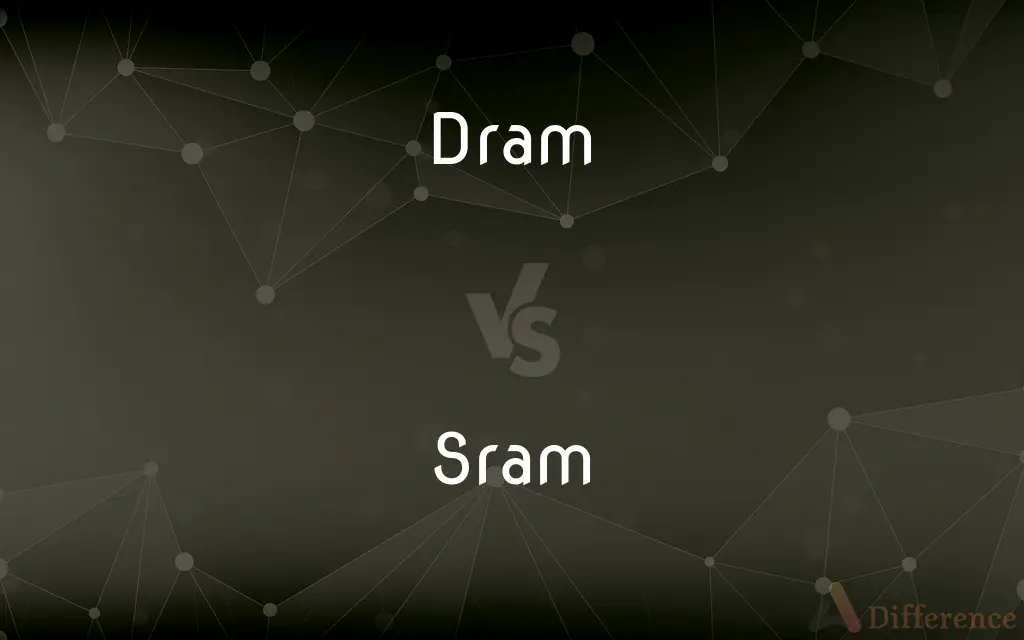DRAM vs. SRAM — What's the Difference?
Edited by Tayyaba Rehman — By Urooj Arif — Updated on March 21, 2024
DRAM is volatile memory known for high density and low cost, suitable for large storage, whereas SRAM is faster, costlier, and used for cache.

Difference Between DRAM and SRAM
Table of Contents
ADVERTISEMENT
Key Differences
Dynamic Random Access Memory (DRAM) stores each bit of data in a separate capacitor within an integrated circuit, making it a dense and cost-effective solution for large volumes of storage. This design, however, requires constant refreshing of the data, leading to slower access times compared to SRAM. Whereas, Static Random Access Memory (SRAM) uses bistable latching circuitry to store each bit, eliminating the need for data refresh and enabling faster access. This makes SRAM ideal for applications requiring quick data retrieval, such as CPU caches.
Due to its simpler structure, DRAM consumes more power and has slower access speeds, making it less efficient for applications needing rapid data processing. On the other hand, SRAM's complex internal structure allows for quicker data access but at a higher power consumption and cost, limiting its use to smaller amounts of memory where speed is critical.
The manufacturing cost of DRAM is lower than that of SRAM due to its higher density and simpler cell structure, making it more economical for mass storage applications. In contrast, SRAM's complex circuitry and lower density translate to higher production costs, making it less favorable for large storage solutions but preferred for high-speed applications.
In terms of application, DRAM is predominantly used in main memory modules due to its cost-effectiveness and large storage capacity. SRAM, with its faster access times, finds its place in the cache memory of processors, where speed is paramount for the performance of the system.
While DRAM requires a refresh cycle to maintain data integrity, leading to additional complexity in its memory controllers, SRAM maintains data as long as power is supplied, simplifying memory management but at the cost of increased power usage.
ADVERTISEMENT
Comparison Chart
Speed
Slower access time
Faster access time
Cost
Less expensive, higher density
More expensive, lower density
Power Consumption
Higher due to refresh cycles
Lower, as it does not require refresh cycles
Application
Main memory for PCs, servers
CPU cache, high-speed applications
Data Volatility
Volatile (loses data without power)
Volatile (loses data without power)
Compare with Definitions
Dram
A type of RAM that stores each bit of data in a separate capacitor, requiring regular refreshing.
Modern computers use DRAM for their main memory due to its cost efficiency and high storage capacity.
Sram
More expensive and consumes more power than DRAM but provides faster data access.
Despite its cost, SRAM is used in critical areas of computers for its speed.
Dram
Suitable for applications where large amounts of data storage are needed at a lower cost.
DRAM is preferred for video game consoles for its large storage capacity.
Sram
Known for its static storage mechanism, eliminating the need for data refresh.
SRAM's no-refresh feature makes it ideal for quick data retrieval tasks.
Dram
Memory technology with dynamic storage approach to manage data.
The server's performance depends heavily on the speed and size of its DRAM.
Sram
Offers non-volatile variants for applications requiring data retention without power.
Non-volatile SRAM is crucial for systems that need to retain data during power outages.
Dram
Characterized by its need for periodic data refreshing to retain information.
DRAM's refresh requirement can impact its overall speed and efficiency.
Sram
A type of RAM that uses bistable latching circuitry to store data, offering faster access times.
High-performance CPUs use SRAM for their cache memory to speed up processing.
Dram
It has a simpler cell structure compared to SRAM, making it less expensive.
The smartphone industry often chooses DRAM to keep device costs down.
Sram
Typically used in small amounts due to its cost and power consumption.
SRAM's usage in cache memory highlights its efficiency in high-speed computing environments.
Dram
A memory chip that depends upon an applied voltage to keep the stored data.
Sram
A type of memory chip which is faster and requires less power than dynamic memory.
Dram
A unit of weight in the US Customary System equal to 1/16 of an ounce or 27.34 grains (1.77 grams).
Sram
Static RAM.
Dram
A unit of apothecary weight equal to 1/8 of an ounce or 60 grains (3.89 grams).
Dram
A small draft
Took a dram of brandy.
Dram
A small amount; a bit
Not a dram of compassion.
Dram
See Table at currency.
Dram
Dynamic RAM.
Dram
(units of measurement) A small unit of weight, variously:
Dram
Alternative form of drachm.
Dram
(pharmacy) drachm.
Dram
(now uncommon) dirhem: a former Turkish unit of weight (variously 1.5–3.5 g).
Dram
(obsolete) drachma: a former Greek unit of weight (about 4.3 g).
Dram
(by extension) Any similarly minute quantity, a small amount of strong alcohol or poison.
A dram of brandy
Dram
A cart formerly used to haul coal in coal mines.
Dram
(obsolete) drachma: a Greek silver coin weighing one drachma; other similar coins.
Dram
The currency of Armenia, divided into 100 luma.
Dram
To drink drams.
Dram
To ply with drams of drink.
Dram
A weight; in Apothecaries' weight, one eighth part of an ounce, or sixty grains; in Avoirdupois weight, one sixteenth part of an ounce, or 27.34375 grains.
Dram
A minute quantity; a mite.
Were I the chooser, a dram of well-doing should be preferred before many times as mush the forcible hindrance of evildoing.
Dram
As much spirituous liquor as is usually drunk at once; as, a dram of brandy; hence, a potation or potion; as, a dram of poison.
Dram
A Persian daric.
Dram
Same as dynamic RAM.
Dram
To drink drams; to ply with drams.
Dram
A unit of apothecary weight equal to an eighth of an ounce or to 60 grains
Dram
1/16 ounce or 1.771 grams
Dram
The basic unit of money in Armenia
Common Curiosities
Why is SRAM faster than DRAM?
SRAM's static design eliminates the need for data refreshing, allowing for quicker data access.
Can DRAM be used for cache memory?
While possible, DRAM is generally too slow for cache memory, making SRAM the preferred choice for this application.
What is DRAM?
DRAM is a type of volatile memory that stores data in capacitors, requiring periodic refreshing.
Why is DRAM cheaper than SRAM?
DRAM's simpler cell structure and higher density make it more cost-effective to manufacture than SRAM.
What makes SRAM suitable for CPU cache?
Its fast access times and static nature make SRAM ideal for the quick retrieval demands of CPU cache.
Is SRAM more power-efficient than DRAM?
SRAM consumes more power due to its complex circuitry, despite not requiring refresh cycles.
How do refresh cycles affect DRAM performance?
The need for periodic refreshing can slow down data access times and increase power consumption.
How does the cell structure of DRAM and SRAM differ?
DRAM uses a single capacitor and transistor per bit, whereas SRAM uses several transistors in a bistable latching circuit.
What is SRAM?
SRAM is a faster, static type of RAM that does not require data refreshing, making it suitable for cache memory.
What applications benefit most from DRAM?
DRAM is best suited for main memory in computers and servers, where large storage capacity is needed at a lower cost.
Can SRAM replace DRAM in all applications?
Due to its higher cost and power consumption, SRAM is not practical for large storage applications where DRAM excels.
What are the main differences between DRAM and SRAM?
The main differences lie in speed, cost, power consumption, and application suitability.
What advancements have been made in DRAM and SRAM technology?
Innovations in both technologies continue to focus on increasing speed, reducing power consumption, and improving density for DRAM and speed for SRAM.
Why is SRAM more expensive than DRAM?
SRAM's complex internal structure and lower density increase its manufacturing costs.
Can the data in DRAM and SRAM be recovered after power loss?
Both DRAM and SRAM are volatile, meaning data is lost when power is removed.
Share Your Discovery

Previous Comparison
Cardinal vs. Bishop
Next Comparison
Alkylation vs. AcylationAuthor Spotlight
Written by
Urooj ArifUrooj is a skilled content writer at Ask Difference, known for her exceptional ability to simplify complex topics into engaging and informative content. With a passion for research and a flair for clear, concise writing, she consistently delivers articles that resonate with our diverse audience.
Edited by
Tayyaba RehmanTayyaba Rehman is a distinguished writer, currently serving as a primary contributor to askdifference.com. As a researcher in semantics and etymology, Tayyaba's passion for the complexity of languages and their distinctions has found a perfect home on the platform. Tayyaba delves into the intricacies of language, distinguishing between commonly confused words and phrases, thereby providing clarity for readers worldwide.














































